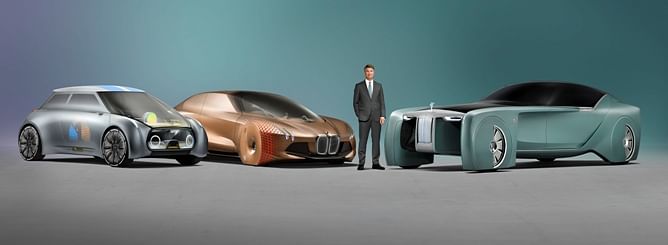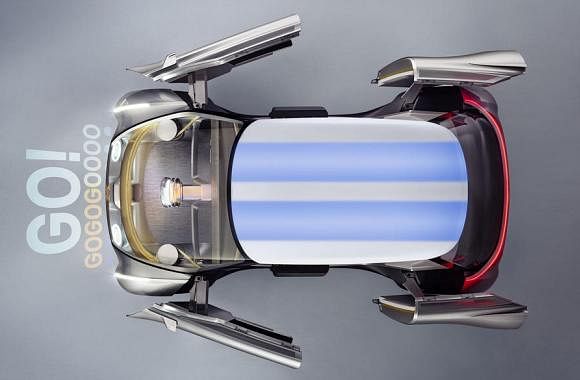Mini reveals Vision Next 100 concept to celebrate BMW's 100th year
Named the Vision Next 100, the compact four-seater showcases a new design lineage that shuns the retro look of today’s Mini models for a cleaner appearance.
Mini has revealed an advanced new concept car to celebrate the 100th anniversary of its parent company, BMW.
Named the Vision Next 100, the compact four-seater showcases a new design lineage that shuns the retro look of today’s Mini models for a cleaner appearance. It has been developed in response to what the company describes as 'an ever more digitalised and interconnected world'.
The Mini concept - which has been unveiled alongside a Vision Next 100 concept from BMW stablemate Rolls-Royce - also highlights Mini’s ambition for future models to offer personal mobility, using the latest in autonomous driving and digital intelligence technology.

L-R: BMW Group's Vision Next 100 concepts from Mini, BMW and Rolls-Royce
The Vision Next 100 can collect its driver from a desired location in fully automated fashion and adapt itself to pre-programmed personalised preferences before it arrives.
Hinting at Mini's broader plans for short term rental of future models through BMW’s CarNow scheme, Adrian von Hooydonk, BMW design boss, said: “It looks to offer bespoke mobility. In the future, you might not actually have to own a vehicle to enjoy the benefits.”
You may like: BMW's Vision Next 100 concept car
As well as providing hands off mobility on a call by call basis, Mini says autonomous driving technology will allow future models previewed by the Vision Next 100 to travel occupant free to a charging station, car wash, garage or the next user.
Despite the focus on digital virtues of the Mini Vision Next 100, von Hooydonk said analogue qualities will become increasingly important in providing cars with a premium air in the future.
As such, the Vision Next 100 has two-piece wheels, which have a static outer surface and a disc behind it that rotates with the tyre. “The idea,” says von Hooydonk is to make each wheel look like 'a piece of mechanical jewellery'.
Holding true to the time honoured Mini maxim of providing the most space possible with the smallest possible footprint, Mini’s design team has succeeded in providing the Vision Next 100 with a body described as being “not so far removed from the first Mini back in 1959” in terms of overall size.
At 3620mm, the Vision Next 100 is 560mm longer than the original Mini, but 270mm shorter than the current Mini hatchback.

The length is significant, as it once again previews plans for a smaller Mini model positioned beneath the existing hatchback, following on from the earlier Rocketman concept.
The compact dimensions are a result of a reduced need for crash zone deformation in future models owing to the adoption of a zero emissions drive system without the bulky mechanical components of a conventional combustion engine, says von Hooydonk.
Mini has not made any firm assertations on the drivetrain used by the Vision Next 100, although officials at its unveiling in London today acknowledged the company is working on various electric solutions using the technical knowhow of its parent company, BMW.
Mini is no stranger to electric cars. It launched its first zero-emission model, the 200bhp Mini-E, back in 2009 as a part of a development program that preceded the establishment of BMW’s i brand and the launch of the i3.
Fitted with a 35kWh lithium ion battery, the Mini-E provided a claimed zero emission range of up to 100 miles.
Despite the emphasis on autonomous driving technology and personalization , Mini says future models will continue to offer the characteristic driving experience offered by today’s models, describing the Vision Next 100 as “small and nimble”.
You may like: Rolls-Royce's Vision Next 100 concept
“A Mini must still be fun, to the extent that drivers will prefer to drive themselves – as often as possible,” says von Hooydonk.
As part of the emphasis on manual driving, Mini has provided its new concept car with a so-called John Cooper Works performance mode, which it says will see the handling characteristics of future models taken to a new level.
Inside, the Vision Next 100 previews much cleaner interior styling for future Mini models than current ones. There’s an uncluttered look to the dashboard, which relies on augmented reality to display a range of different functions, including the information about the route and, when requested, the ideal driving line.
To enhance the feeling of width within the interior, the new concept car adopts a front bench seat and a full-width footwell. According to Mini, this allows ease of access from both sides of the car and makes getting in and out in busy urban environments easier than experienced today.
When the autonomous mode is activated, the steering wheel slides across to a positon in the centre of the dashboard. The pedals slide with the steering wheel to provide increased legroom for the driver. Despite the appearance of autonomous driving technology, Mini says the steering wheel will remain an integral part of the interior in future models.
Read more: BMW Motorrad Vision Next 100
To switch from autonomous driving to manual driving mode, the driver moves the steering wheel from the central position to either the left or right-hand side, depending on where they have chosen to sit.
The centrepiece of the interior is the so-called Cooperizer. Incorporated in large centrally positioned circular instrument styled to resemble the central round dial of original Mini models, it allows the driver to choose differing set-ups for a range of functions, including the autonomous driving, entertainment and communication systems, as part of efforts to provide greater personalisation. Depending on the set-up that is chosen, the Cooperizer then lights up in a range of different colours.
By pushing the 'Inspire Me' button, the driver can also access digital data relating to his/her location or route. When the Vision Next 100 detects a suitable driving road, it allows the driver to switch into John Cooper Works performance model for ultimate performance potential.
With car sharing set to increase, Mini also says interiors will need to be harder wearing in the future. Its latest concept uses a combination of recycled plastic and aluminium in the floor, roof and side panels. Steering clear of traditional materials such as wood, leather and chrome, the interior of the Vision Next 100 also includes brass, basalt and cellulose.
Also read: BMW shifts focus to autonomous tech with Project i Next
RELATED ARTICLES
Autoliv Plans JV for Advanced Safety Electronics With China’s HSAE
The new joint venture, which is to be located strategically near Shanghai and close to several existing Autoliv sites in...
JLR to Restart Production Over a Month After September Hacking
Manufacturing operations at the Tata Group-owned British luxury car and SUV manufacturer were shut down following a cybe...
BYD UK Sales Jump 880% in September to 11,271 units
Sales record sets the UK apart as the largest international market for BYD outside of China for the first time. The Seal...






 16 Jun 2016
16 Jun 2016
 5944 Views
5944 Views


































 Ajit Dalvi
Ajit Dalvi




